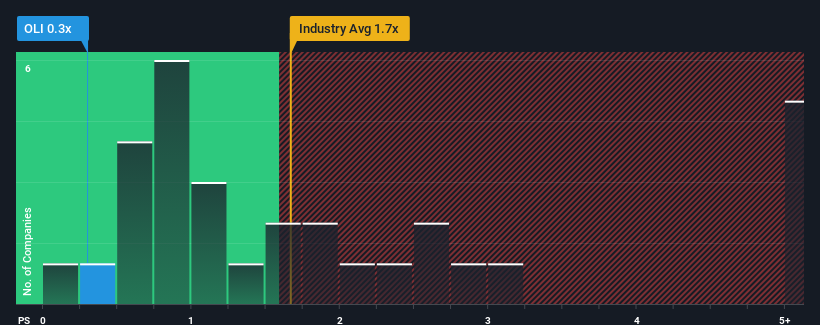- Australia
- /
- Hospitality
- /
- ASX:OLI
There's No Escaping Oliver's Real Food Limited's (ASX:OLI) Muted Revenues Despite A 31% Share Price Rise

Oliver's Real Food Limited (ASX:OLI) shares have had a really impressive month, gaining 31% after a shaky period beforehand. Looking further back, the 21% rise over the last twelve months isn't too bad notwithstanding the strength over the last 30 days.
In spite of the firm bounce in price, given about half the companies operating in Australia's Hospitality industry have price-to-sales ratios (or "P/S") above 1.7x, you may still consider Oliver's Real Food as an attractive investment with its 0.3x P/S ratio. Nonetheless, we'd need to dig a little deeper to determine if there is a rational basis for the reduced P/S.
Check out our latest analysis for Oliver's Real Food

How Oliver's Real Food Has Been Performing
For example, consider that Oliver's Real Food's financial performance has been pretty ordinary lately as revenue growth is non-existent. Perhaps the market believes the recent lacklustre revenue performance is a sign of future underperformance relative to industry peers, hurting the P/S. Those who are bullish on Oliver's Real Food will be hoping that this isn't the case, so that they can pick up the stock at a lower valuation.
We don't have analyst forecasts, but you can see how recent trends are setting up the company for the future by checking out our free report on Oliver's Real Food's earnings, revenue and cash flow.How Is Oliver's Real Food's Revenue Growth Trending?
The only time you'd be truly comfortable seeing a P/S as low as Oliver's Real Food's is when the company's growth is on track to lag the industry.
Retrospectively, the last year delivered virtually the same number to the company's top line as the year before. Fortunately, a few good years before that means that it was still able to grow revenue by 8.7% in total over the last three years. So it appears to us that the company has had a mixed result in terms of growing revenue over that time.
Comparing the recent medium-term revenue trends against the industry's one-year growth forecast of 9.6% shows it's noticeably less attractive.
With this information, we can see why Oliver's Real Food is trading at a P/S lower than the industry. Apparently many shareholders weren't comfortable holding on to something they believe will continue to trail the wider industry.
What Does Oliver's Real Food's P/S Mean For Investors?
The latest share price surge wasn't enough to lift Oliver's Real Food's P/S close to the industry median. Using the price-to-sales ratio alone to determine if you should sell your stock isn't sensible, however it can be a practical guide to the company's future prospects.
In line with expectations, Oliver's Real Food maintains its low P/S on the weakness of its recent three-year growth being lower than the wider industry forecast. At this stage investors feel the potential for an improvement in revenue isn't great enough to justify a higher P/S ratio. Unless the recent medium-term conditions improve, they will continue to form a barrier for the share price around these levels.
You should always think about risks. Case in point, we've spotted 4 warning signs for Oliver's Real Food you should be aware of, and 3 of them make us uncomfortable.
If companies with solid past earnings growth is up your alley, you may wish to see this free collection of other companies with strong earnings growth and low P/E ratios.
New: AI Stock Screener & Alerts
Our new AI Stock Screener scans the market every day to uncover opportunities.
• Dividend Powerhouses (3%+ Yield)
• Undervalued Small Caps with Insider Buying
• High growth Tech and AI Companies
Or build your own from over 50 metrics.
Have feedback on this article? Concerned about the content? Get in touch with us directly. Alternatively, email editorial-team (at) simplywallst.com.
This article by Simply Wall St is general in nature. We provide commentary based on historical data and analyst forecasts only using an unbiased methodology and our articles are not intended to be financial advice. It does not constitute a recommendation to buy or sell any stock, and does not take account of your objectives, or your financial situation. We aim to bring you long-term focused analysis driven by fundamental data. Note that our analysis may not factor in the latest price-sensitive company announcements or qualitative material. Simply Wall St has no position in any stocks mentioned.
About ASX:OLI
Moderate and slightly overvalued.


